Text
x
#reparations#racial justice#historical trauma#systemic racism#social inequality#discrimination#victim blaming#racial bias#Black empowerment#reparative justice#economic disparities#social equity#civil rights#racial inequality#reparations debate#historical oppression#racial stereotypes#social exclusion#institutionalized racism#marginalized communities#racial discrimination#socioeconomic barriers#justice for descendants of enslaved people#051824
7 notes
·
View notes
Photo


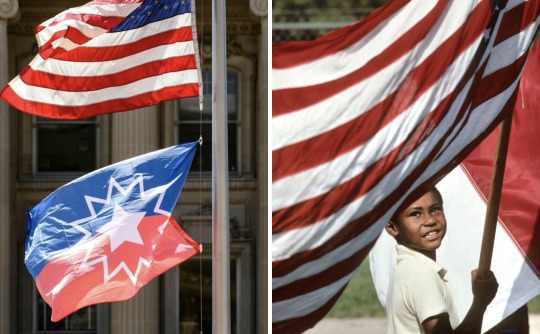


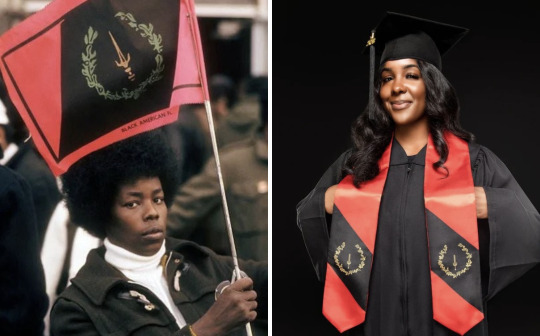
Juneteenth is a Black American holiday.
We call Juneteenth many things: Black Independence Day, Freedom Day, Emancipation Day, Jubilee Day. We celebrate and honor our ancestors.
December 31 is recognized as Watch Night or Freedom’s Eve in Black American churches because it marks the day our enslaved ancestors were awaiting news of their freedom going into 1863. On January 1, 1863, President Lincoln issued the Emancipation Proclamation. But all of the ancestors wouldn’t be freed until June 19, 1865 for those in Galveston, Texas and even January 23, 1866 for those in New Jersey (the last slave state). (It’s also worth noting that our people under the Choctaw and Chickasaw Nations wouldn’t be freed until April 28, 1866 and June 14, 1866 for those under the Cherokee Nation by way of the Treaties.)
Since 1866, Black Americans in Texas have been commemorating the emancipation of our people by way of reading the Emancipation Proclamation and coming together to have parades, free festivities, and later on pageants. Thereafter, it spread to select states as an annual day of commemoration of our people in our homeland.
Here’s a short silent video filmed during the 1925 Juneteenth celebration in Beaumont, Texas:
youtube
(It’s also worth noting that the Mascogos tribe in Coahuila, Mexico celebrate Juneteenth over there as well. Quick history lesson: A total of 305,326 Africans were shipped to the US to be enslaved alongside of American Indians who were already or would become enslaved as prisoners of war, as well as those who stayed behind refusing to leave and walk the Trail of Tears to Oklahoma. In the United States, you were either enslaved under the English territories, the Dutch, the French, the Spanish, or under the Nations of what would called the Five “Civilized” Native American Tribes: Cherokee, Creek (Muscogee), Chickasaw, Choctaw, and Seminoles. Mascogos descend from the Seminoles who escaped slavery during the Seminole Wars, or the Gullah Wars that lasted for more than 100 years if you will, and then settled at El Nacimiento in 1852.)
We largely wave our red, white and blue flags on Juneteenth. These are the only colors that represent Juneteenth. But sometimes you may see others wave our Black American Heritage flag (red, black, and gold).
Juneteenth is a day of respect. It has nothing to do with Africa, diversity, inclusion, immigration, your Pan-African flag, your cashapps, nor your commerce businesses. It is not a day of “what about” isms. It is not a day to tap into your inner colonizer and attempt to wipe out our existence. That is ethnocide and anti-Black American. If you can’t attend a Black American (centered) event that’s filled with education on the day, our music, our food and other centered activities because it’s not centered around yours…that is a you problem. Respect our day for what and whom it stands for in our homeland.
Juneteenth flag creator: “Boston Ben” Haith
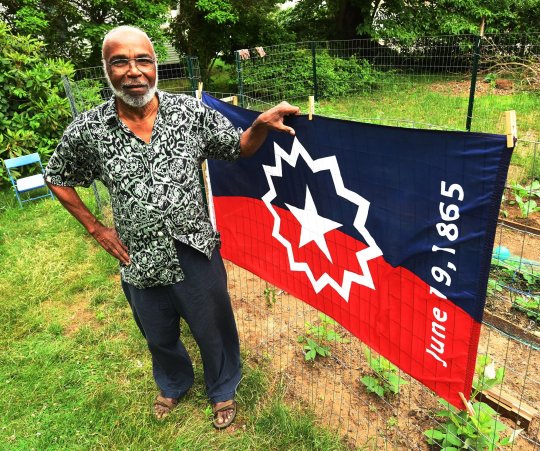
It was created in 1997. The red, white and blue colors represent the American flag. The five-point star represents the Lone State (Texas). The white burst around the star represents a nova, the beginning of a new star. The new beginning for Black Americans.
Black American Heritage Flag creators: Melvin Charles & Gleason T. Jackson

It was created in 1967, our Civil Rights era. The color black represents the ethnic pride for who we are. Red represents the blood shed for freedom, equality, justice and human dignity. Gold fig wreath represents intellect, prosperity, and peace. The sword represents the strength and authority exhibited by a Black culture that made many contributions to the world in mathematics, art, medicine, and physical science, heralding the contributions that Black Americans would make in these and other fields.

SN: While we’re talking about flags, I should note that Grace Wisher, a 13-year-old free Black girl from Baltimore helped stitched the Star Spangled flag, which would inspire the national anthem during her six years of service to Mary Pickersgill. I ain’t even gon hold you. I never looked too far into it, but she prob sewed that whole American flag her damn self. They love lying about history here until you start unearthing them old documents.
In conclusion, Juneteenth is a Black American holiday. Respect us and our ancestors.
#juneteenth#juneteenth flag#black american history#black american culture#ben haith#black american heritage flag#melvin charles#gleason t jackson#grace wisher#american flag#mascogos#juneteenth 2023
1K notes
·
View notes
Text
Non-paywall version here.
"When Arley Gill, head of Grenada’s National Reparations Committee, envisioned his work seeking repair for centuries of enslavement on the Caribbean island, one thing was certain: It was going to be a long slog.
But just two years since its founding, the task force is fielding calls from individuals around the world looking to make amends for ancestors who benefited from enslavement in Grenada.
“If you had told us this would be happening, we wouldn’t have believed you,” Mr. Gill says, crediting a burgeoning movement of descendants of enslavers getting wise to their family’s history and taking action.
In Grenada’s case, the momentum began with a public apology made by former BBC journalist Laura Trevelyan and her family in February at a ceremony on the island. They apologized for their forebears’ enslavement of people in Grenada and their enrichment from it, pledging an initial contribution of £100,000 ($130,000) toward education on the island.
“She opened the doors for people to feel comfortable” coming forward, says Mr. Gill.
In April [2023], Ms. Trevelyan and journalist Alex Renton co-founded an organization called Heirs of Slavery. Its eight British members have ancestors who benefited financially from slavery in various ways...
Heirs of Slavery says wealth and privilege trickle down through generations, and that there are possibly millions of Britons whose lives were touched by money generated from enslavement.
The group aims to amplify the voices of those already calling for reparations, like Caribbean governments. And it supports organizations working to tackle the modern-day consequences of slavery, both in the United Kingdom and abroad, from racism to health care inequities. But it’s also setting an example for others, drafting a road map of reparative justice for enslavement – at the individual level...
“Shining a light is always a good idea,” says Mr. Renton, who published a book in 2021 about his family’s ties to slavery, donating the proceeds to a handful of nongovernmental organizations in the Caribbean and England. “You don’t have to feel guilt about it; you can’t change the past,” he says, paraphrasing Sir Geoff Palmer, a Scottish Jamaican scholar. “But we should feel ashamed that up to this point we’ve done nothing about the consequences” of slavery.
Start anywhere
Most Africans trafficked to the Americas and Caribbean during the trans-Atlantic slave trade ended up in the West Indies. The wealth generated there through unpaid, brutal, forced labor funded much of Europe’s Industrial Revolution and bolstered churches, banks, and educational institutions. When slavery was abolished in British territories in 1833, the government took out a loan to compensate enslavers for their lost “property.” The government only finished paying off that debt in 2015.
The family of David Lascelles, the 8th Earl of Harewood, for example, received more than £26,000 from the British government after abolition in compensation for nearly 1,300 lives, while “the enslaved people were given nothing,” Mr. Lascelles says. He joined Heirs of Slavery upon its founding, eager to collaborate with peers doing work he’s been focused on for decades.
“People like us have, historically, kept quiet about what our ancestors did. We believe the time has come to face up to what happened, to acknowledge the ongoing repercussions of this human tragedy, and support the existing movements to discuss repair and reconciliation,” reads the group’s webpage.
For Ms. Trevelyan, that meant a very public apology – and resigning from journalism to dedicate herself to activism...
For Mr. Lascelles, a second cousin of King Charles, making repairs included in 2014 handing over digitized copies of slavery-related documents discovered in the basement of the Downton Abbey-esque Harewood House to the National Archives in Barbados, where much of his family’s wealth originated during enslavement.
“What can we do that is actually useful and wanted – not to solve our own conscience?” he says he asks himself...
“Listen and learn”
...The group is planning a conference this fall that will bring together families that benefited from the trans-Atlantic slave trade along with representatives from Caribbean governments and Black Europeans advocating for reparations. In the meantime, members are meeting with local advocacy groups to better understand what they want – and how Heirs of Slavery might assist.
At a recent meeting, “there was one man who said he wanted to hear what we had to say, but said he saw us as a distraction. And I understand that,” says Mr. Renton. “Maximum humility is necessary on our part. We are here to listen and learn, not try to take the lead and be the boss.”
Mr. Renton’s family has made donations to youth development and educational organizations, but he doesn’t see it as compensation. “I see this as work of repair. If I sold everything I own, I couldn’t begin to compensate for the lives my ancestors destroyed,” he says."
-via The Christian Science Monitor, August 1, 2023
Note: I know the source name probably inspires skepticism for a lot of people (fairly), but they're actually considered a very reliable and credible publication in both accuracy and lack of bias.
#slavery#reparations#antiblackness#racism#colonialism#united kingdom#uk#granada#caribbean#social justice#ancestry#black history#black lives matter#reparative justice#enslavement#abolition#systemic racism#good news#hope
242 notes
·
View notes
Text
Happy Emancipation Day!
Here's a short write up I did about Emancipation Day for my local grassroots mutual aid collective. This will unfortunately be focused primarily on Canada because our area of influence is more local than international. Please be sure to educate yourself on what this day means in your region!
What is the Slave Abolition Act of 1833?
The Slave Abolition Act of 1833 was a British law that ended slavery in most British colonies, freeing over 800,000 enslaved Africans in the Caribbean, South Africa, and Canada. The law, approved on August 28, 1833, took effect on August 1, 1834. It did not immediately apply to territories controlled by the East India Company, Ceylon, or Saint Helena; these exceptions were removed in 1843.
Earlier, in 1793, John Graves Simcoe, the first Lieutenant Governor of Upper Canada (now Ontario), had passed an Act Against the importation of new slaves. This law promised freedom to children born to enslaved women at age twenty-five, but it did not free existing slaves. The Slavery Abolition Act of 1833 later replaced this law, ending slavery across most of the British Empire.
Did it really free the slaves?
The Slavery Abolition Act had its flaws. It only freed those enslaved under age six. Older individuals were classified as 'apprentices' and had to work 40 hours a week without pay as “compensation” to their former slave owners. Full emancipation was not achieved until July 31, 1838.
While Canada often expresses pride in its relatively lesser involvement in slavery when compared to other British colonies, it wasn't the first to end it. The Independent Republic of Vermont was the first in North America to abolish slavery with its 1777 constitution. This came 16 years before Upper Canada’s partial abolition in 1793. Vermont was quickly followed by states like Pennsylvania and Massachusetts, and the U.S. Congress banned slavery in future Midwest territories in 1787.
What is Emancipation Day? What does it mean?
On March 1, 2021, the Canadian House of Commons unanimously declared August 1 as Emancipation Day. This date marks the beginning of the partial abolition of slavery across British colonies in various countries.
Why is Emancipation Day important?
Neglecting acknowledgement of Emancipation Day allows Canada to evade its dark history and distort its legacy. We must hold governments accountable for the history of their crimes. It’s critical to confront the reality that slavery was a part of Canadian history and that its legacy continues to impact African Canadians today. While Canada often boasts about its role in the Underground Railroad and its “total” abolishment of slavery before the U.S, it must also face the uncomfortable truth of its own very real involvement in slavery. Emancipation Day is about confronting history with honesty. Acknowledging this day is essential for addressing past injustices and ensuring that future generations grasp the full, unfiltered truth of Canada's history, including the painful chapters that must not be forgotten or repeated.
Emancipation did not end the oppression of Black people in this country. For those who suffered under centuries of slavery, emancipation should have signaled that Canada would become a place of respect and opportunity for their descendants. Instead, Black Canadians still face racism, discrimination, and prejudice in education, healthcare, housing, and the justice system.
The history of slavery and the stories of enslaved people and their descendants have historically been confined to Black communities. Recognition of this day on a national scale not only helps to validify the black experience, but also to clearly acknowledge our refusal to return to these oppressive norms. Integrating this crucial part of Canadian history into the education of all our children is vital for addressing anti-Black racism and its ongoing impact in our society to this day. A necessary step toward justice is issuing an official apology to the descendants of enslaved people, bringing this issue to the forefront of Canadian awareness and starting the path toward meaningful reparations.
Emancipation day allows us the opportunity to use the past to reflect upon the present. We must acknowledge the deep, ongoing trauma from slavery and segregation as the foundation of anti-Black racism that is still rampant in our justice system today. It is only through this acknowledgement that we can begin to form a dialogue which sees black people as an important, intrinsic part of Canadian history at all times, not just during black history month.










#blacklivesmatter#emancipation#radical education#mutual aid#police abolition#history#pagan#paganism#racial justice#social justice#black history#black indigenous#canadian history#black lives matter#revolution
20 notes
·
View notes
Note
I am so glad you articulated the criticism of Dany crucifying the slavers as a political folly and not a moral folly like listen I am a Dany fan if I could send asks from my sideblog you would know this but I do not believe we are supposed to just brush off the crucifixion like Dany herself isn’t even fully convinced it was the right thing to do. Remembering it she feels sick and has to shut down her doubts and TELL HERSELF it was right. She is an interesting character to me because she can’t stand the compromises she must make to maintain peace AND YET she does want justice and liberation BUT she also hates the suffering and bloodshed of war AND YET she is quick to command violence on impulse. I do think her peace in Meereen was real (big Meereen Knot Essays believer) but all of her internal conflicts lead her to her mistakes. Can’t stand peace but can’t stand war so she just tears herself apart!! It’s tragic! It’s interesting! So much more interesting than an unambiguously heroic Dany who makes no mistakes ever!
Yeah, like....it's certainly morally messy, and I think it's morally more messy because Dany isn't a slave of the Ghiscari like Missandei or an Unsullied like Grey Worm, Red Lamb, etc who is rising up and using violent revolution to liberate the slave class of Meereen - she is a descendant from a foreign, formerly slaving culture that enslaved most of the cultures represented in Meereen, someone of noble birth who has experienced immense suffering but was able to pull herself out of it because of her immense social privilege and magical abilities, using violence in an attempt to liberate those her family had once helped subjugate while...still keeping herself at the top of the pyramid.
There's a lot of mess and contradictions in this situation and I find it much less interesting (as you say) when people paint what Dany is doing here as unambiguously heroic. I know I sound like a broken clock when I say it, but the justification of "well this culture has slavery and slavery is bad" is the exact sort of rationalization many colonial and imperial powers make when conquering. White Americans made it about various Indigenous communities ("oh well the Iroquois had slaves and conquered their neighbors" yeah and white americans had chattel slavery which is objectively worse so what now??), the UK and France used it as a rationale for conquering most of Africa and parts of Asia; there's always this annoying through-line of "well Africans sold themselves into slavery" and I think making this argument that "Well the Ghiscari are brutal slavers" is really similar. And I know people don’t like the dragon/nuke comparison or the imperialism/colonizer comparisons but….what made the genocides of the Americas, and the colonization and imperialism of the 20th centuries stand out from the wars that came before is the sort of hellish combination of nationalism, political schisms, fervent hatred of the Other, and industrial growth. Never before could people amass armies and kill on such a massive scale before. Never before did we have weapons that were so fucking good at killing. Never before did we have the bureaucracy capable of streamlining the process so damn well! (and not for lacking of trying, shout out rome but like...still). I think the dragons are a commentary on that - when someone has access to technology like that, can one person be left to decide if it’s use is good or evil? can one culture not be completely corrupted by their technological advances? can nuclear bombs or weapons Ever be used for good, and if they can be then where is that line drawn? who draws the line? why does that person get to draw the line? I don't think any of this will have a clear answer because that's not exactly how he does things - he's just writing a scenario about this and letting us analyze why it happens on our own.
So it’s like okay the Ghiscari and Dothraki are slaving cultures...Sacking a city is still a violent, destructive thing to do and she does it three times including to a city she is attempting to rule. The moment she had an inkling she might be ruling Meereen, she should have rethought her actions there so she doesn’t start off alienating a large group of people. Coming in as a stranger from a culture who used to be slavers and constantly making comments about how much she hates the culture she’s ruling over is....not great! Dany going back and forth between "I hate these people I was right to crucify them" and "there's too much violence amongst these people I have to stop the violence" is why the issues in Meereen become so complicated. Does she have reasons for acting this way? Yes! It doesn't change the outcome of her actions!
What's interesting about her is that as you say, she does realize this conflicting dichotomy within herself! That’s like, the entire issue she’s facing in Meereen - she wants peace because she knows that’s what’s best for the people there and yet struggles to control her boredom and temper because she is too traumatized to sit still any longer. She’s associated the constant move, the constant fight, the violence and blood and death and destruction with righteousness, justice, goodness, and we can SEE it’s having a negative effect on her psyche, her emotions. She’s not HAPPY by the ending of adwd, she’s not self actualized, she’s just hardened herself completely in the face of this unending monster of a campaign. She wants off this ride and yet she’s unable to find a way out. I don’t think we’re meant to cheer her on here!! SHE is barely cheering herself on here!!! It’s a burden to her!!!!
#asks#anons#anti daenerys targaryen#again....it's an anti tag for filtering purposes i'm not calling her evil i'm calling her an extremely dark morally gray on a bad road#the way like. theon in acok is or robb in asos is or cersei jaime and tyrion all are always.#she worries me the way arya worries me!!! murdering is not healthy for your mind!!!#it's just that. arya has a support system. and dany doesn't. and that sucks!! but sometimes...#your life is just one part decision and two parts luck!#i hope i don't sound like i'm talking out of my ass here i am admittedly rusty on my Academic Theory About Imperialism#and also like. i'm at work on lunch alkdfjskdj#my anons are so smart and i am just a dumb bitch with indigenous heritage a community college degree and an internet connection alsjdf
21 notes
·
View notes
Text

Dear Friends: Please attend the Juneteenth Reparations March And Rally on Saturday, June 22, 2024. The march is scheduled to start 12:00 Noon at the Lincoln Monument, 12 Springfield Avenue (Intersection of Springfield Avenue & West Market Street) in Newark, NJ. However, please try to arrive early if possible. This would help us to start the march on time. The purpose of the march is to show support for and demand passage of state and federal legislation dealing with reparations for the descendants of enslaved Africans in the United States. The march is endorsed by the People’s Organization For Progress, New Jersey Institute for Social Justice, and other organizations. Please inform family, friends, neighbors, and co-workers about the march and encourage them to attend. Also, reach out to other organizations, community groups, religious institutions, unions, and fraternal associations that you are a part of and encourage them to attend. We are also looking for additional organizations to endorse the march. Volunteers are needed to assist with a number of tasks including phone banking, and leaflet distribution at the march. If you would like to volunteer, inform us of new endorsers, or have any questions or need additional information please call 973 801-0001. I look forward to seeing you at the march. Thank you. Reparations Now!!! Power To The People!!! Sincerely, Lawrence Hamm Chairman People’s Organization For Progress
12 notes
·
View notes
Text
Journalism delenda est, continued
If Fox News really were the right-wing hate-machine that Democrats love to imagine, Fox could spin off a channel with a name like Blacks Behaving Badly, which would be simply continuous coverage of murders and rapes committed by blacks.
Blacks Behaving Badly could easily get 24-hour material of constantly new crimes by giving merely an hour to each black murder or black rape, because blacks commit those crimes about hourly in America. (Compare the way left-wing press is still bleating about Emmett Till.) The information on BBB would all be true, of course, and the channel would be dedicated to covering some matters and not others, which is inevitable because every TV channel has to make some decisions about what to include of the millions of events that happen every day.
It would still be a wicked, shit-stirring, hate-inciting, no good, very bad, racebait channel with a chronic shortage of redeeming features, whose selective coverage would be obviously malicious.
I bring up this hypothetical construct as a point of comparison for the wicked bit of shit-stirring racebait and so forth that recently came out of Reuters in real life: a special report on how U.S. leaders have slaveholding ancestors. Chronic shortage of redeeming features.

Shoddy's line pretty much sums it up, but let's look at the special report a bit more.
In a special bit of adding insult to injury, it violates usability guidelines by hijacking scroll commands (mousewheel, arrow keys, etc) before we get to the main content. Here is the page as it looks when it first loads:

And here is the page as it looks after I hit the Page Down key:
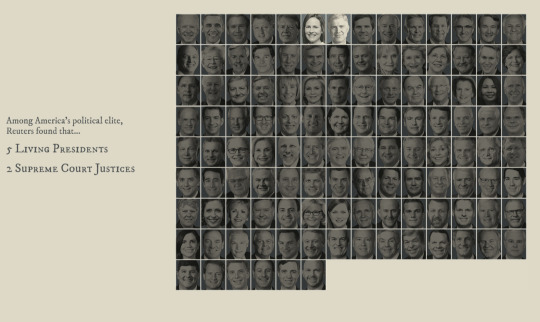
These self-important theater kids made a fucking unskippable opening cutscene out of a fucking webpage. The Down arrow key does nothing here. The Page Down key pressed a second time merely advances the gradually revealing text by two lines, while changing the image's highlight. Page Down should skip me past the fucking image-video-hybrid-animation and move me down the page.
Then we get to the content. I shall excerpt and quote full paragraphs here.
More than 100 U.S. leaders – lawmakers, presidents, governors and justices – have slaveholding ancestors, a Reuters examination found. Few are willing to talk about their ties to America's “original sin”
Everyone Has Slaveholding Ancestors.
I can forgive the tweeter for being space-constrained and having to drop terms that can be inferred from context. The text in the full report (not headline), a page down, has no such excuse. Perhaps you say "it's obvious what they mean from context", but I assure you, it is not in fact obvious and the clarification further down is not the obvious one.
Many lawmakers need look no further than their own family histories to find a much more personal connection to slavery in America, a brutal system of oppression that resulted in the deadliest conflict in U.S. history.
Second deadliest, unless something very odd happened with WW2 since last time I checked. (Perhaps they're using a special metric like "deaths on American soil", I imagine.)
In researching the genealogies of America’s political elite, a Reuters examination found that a fifth of the nation’s congressmen, living presidents, Supreme Court justices and governors are direct descendants of ancestors who enslaved Black people.
And here's a clarification of "slaveholding ancestors", three fucking pages into the special report: ancestors who enslaved the Reverentially Capitalized Race. Doesn't count if they enslaved Persons of Pallor.
Except that paragraph is still wrong, descriptively and normatively. We'll see further down in the report that it's not counting the Africans who enslaved other Africans, such as Ayuba Suleiman Diallo. Or the extensive history of Islamic slavery, which via Andalusian intermarriage to the Spanish royal family and from there to the American colonies, results in a great many more descendants of people who enslaved persons-of-the-favored-race. Reuters put a great deal of work into studying a subject it frequently contradicts itself about the bounds of.
In addition, President Joe Biden and every living former U.S. president – except Donald Trump – are direct descendants of slaveholders: Jimmy Carter, George W. Bush, Bill Clinton and – through his white mother’s side – Barack Obama. Trump’s ancestors came to America after slavery was abolished.
This is racebait, journalism delenda est, everyone who wrote this should be banned from public communication.
Two of the nine sitting U.S. Supreme Court justices – Amy Coney Barrett and Neil Gorsuch – also have direct ancestors who enslaved people.
Everyone has direct ancestors who enslaved people.
I am going to keep harping on this for as long as Reuters keeps playing fast and loose with words. This special report online does not have the space constraints of a physical newspaper, nor does it have the time constraints of having to report on urgent news with a deadline tomorrow. It is written by supposedly professional wordsmiths with alleged editors and so-called fact-checkers. It has the leisure to get things right. It's welcome to use shorthand after getting things right (and preferably noting the shorthand), but Reuters has not gotten it right yet and will continue to contradict itself.
South Carolina, where the Civil War began, illustrates the familial ties between the American political elite and the nation’s history of slavery. Every member of the state’s nine-person delegation to the last Congress has an ancestral link. The state’s two Black members of Congress – Senator and Republican presidential candidate Tim Scott and Representative James Clyburn, a powerful Democrat – have forebears who were enslaved. Each of the seven white lawmakers who served in the 117th Congress is a direct descendant of a slaveholder, Reuters found. So too is the state’s Republican governor, Henry McMaster.
I assure you that everyone involved here has forebears who were enslaved and is the direct descendant of a slaveholder. If you're going to contrast the two, get the specifics right.
This is racebait, journalism delenda est, everyone who wrote this should be banned from public communication and have a finger cut off as a continual reminder of their sins.
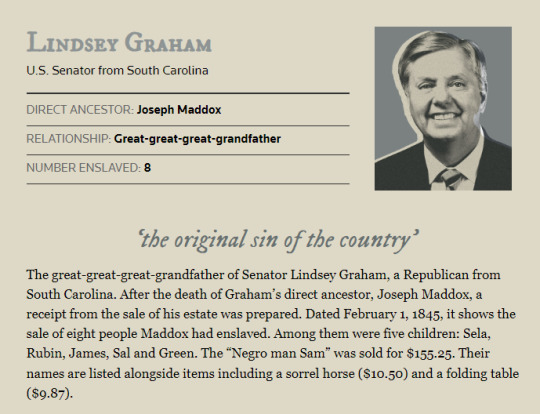
There's a bunch of specific people and degree of relation listed. I'll skip past them to see where Reuters is fucking around again.
A Reuters/Ipsos poll for this report suggests that a politician’s links to slavery might sway some voters. In a national survey, almost a quarter of respondents – 23% – said knowing that a candidate’s ancestors enslaved people would make them less likely to vote for that candidate. That number rose to 31% among respondents who identified as Democrats, and 35% among Black respondents. What’s unclear is how significant the topic is compared to race relations more broadly or other hot-button issues such as abortion.
Bold mine, Reuters really cannot keep this straight, this does not match their previous special report statements, and it also doesn't match the wording that was actually used in the poll. The poll respondents weren't given this whole special report for implicit context when they were asked:
“Would knowing that a political candidate’s ancestors or family members owned slaves in America make you more or less likely to vote for them?”
Journalism
Delenda
Est.
66 notes
·
View notes
Text
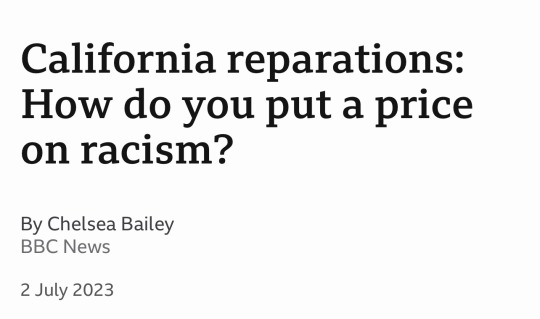

Alvin Taylor and his sister, Pearl, were kids when the City of Palm Springs, California began burning down their neighbours' homes. But they still remember the smell of the smoke.
"We would come home, and a neighbour's house would be gone - just burned rubble," Pearl Taylor Devers said.
In 1965, the City of Palm Springs began razing the Taylors' predominantly black neighbourhood to make way for commercial development near the city centre. Their father, a carpenter, had built their modest home from the foundation up. Their mother, a house cleaner, had worked for celebrities like Lucille Ball and the family of Amelia Earhart, and took the children to church every Sunday.
The Taylors grew up in an area of Palm Springs known as Section 14; racial segregation made the neighbourhood one of the few places where black people could purchase a home.
But that was before the fires. Every week a new home would go up in flames - sometimes with a neighbour's belongings inside. The Taylor family moved from home to home in Section 14, trying to outrun the flames. Each time their house was destroyed.
After a lengthy investigation, a 1968 report from the California Department of Justice deemed the destruction of Section 14 a "city-engineered holocaust".

Onlookers watch a "controlled burn" of a home in Section 14 of Palm Springs.
Nearly six decades later, survivors of Section 14 could finally see restitution after the California Department of Justice Reparations Task Force issued a sweeping set of reparations proposals last week.
The thousand-page report sets out 115 legislative recommendations to address inequalities among black Californians and ensure that injustices - like the destruction of Section 14 - never happen again.
Among the recommendations is a controversial proposal for cash payments of at least $1.2m (£943,400) to each black descendant of slaves.
Members of the task force said they hope their report helps the public understand the true cost of racism in California, regardless of whether the government ends up deciding to give direct cash payments or not.
The issue is highly divisive in the state. A new poll from the Public Policy Institute of California found that 54% of likely California voters had an unfavourable view of the task force, while nearly the same amount, 59%, believe the state should offer a formal apology for human rights violations and crimes against humanity on African slaves and their descendants.
The atmosphere was charged on Thursday, when the report was presented to the public, with some saying payments could not come soon enough.
"It's my money, and I want it now," one woman yelled.
Others said it was unfair to ask this generation to pay for the sins of the past through reparations that will ultimately be funded by tax dollars.
California Republican Assembly member Bill Essayli, who is Lebanese-American, said he opposes the recommendations of the task force.
"This whole thing of focusing on people's race and victimhood, [it] is nothing but an attempt to divide Americans and pit them against each other," he told the BBC.
Nothing untouched by racism
This debate is nothing new. Americans have argued over the idea of reparations since the end of the Civil War.
In recent years since, members of Congress have tried - and failed - to establish a commission to study proposals for reparations for African Americans.
While reparations efforts might have stalled on the federal level, local discussions have intensified, especially in the years since the murder of George Floyd. Evanston, Illinois became the first city in the US to give financial compensation for racist housing discrimination. But California's plan, if implemented, would be the most sweeping to date.
Dr Cheryl Grills, a clinical psychologist who specialises in racial trauma and was appointed to the task force, said it is necessary to acknowledge how the past continues to impact people today.
"Enslavement may have ended, but the ideology and the mechanisms to try to keep black people at the bottom are very much still with us," Dr Grills said.

Nothing is left of the Taylors' home but rubble. It was destroyed more than 60 years ago, but the lot remains empty.
It's a lesson the Taylors say they learned first-hand. They say the destruction of their home in Section 14 formed a core memory that would shape the rest of their lives.
Their father, a proud man, refused to abandon the home he built for his family. He tried in vain to secure a loan to buy the land, but at a time when most banks refused to give black Americans mortgages, he was left with few options.
(continue reading)
#politics#reparations#section 14#alvin taylor#racism#structural racism#black history#palm springs#california#white domestic terrorism#white supremacy
59 notes
·
View notes
Text
Campaigner Patrick Vernon calls for meaningful action, not just words, from descendants of Britain’s wealthy slave owners, following their recent public apology in Jamaica for their families’ ties to the Transatlantic slave trade A Black British social justice campaigner is calling for the descendants of slave owners who have apologised for their family’s historic links to slavery to directly address the question of reparations. Patrick Vernon OBE made the call following several members of campaign group Heirs of Slavery – which is made up of descendants of some of Britain’s most wealthiest slave owners – delivered an apology to the people of Jamaica earlier this year. Speaking to The Voice, he said: “Any apology is always a positive step forward, but an apology must be linked to the issue of reparations. “What’s important for these families that apologise, is to have a proper engagement process and co-creation around what is reparations based on the experiences either on the Caribbean islands or in the UK.”
continue reading
2 notes
·
View notes
Text
https://www.reuters.com/investigates/special-report/usa-slavery-families/
Heirs of Power

The forebears of three members of Congress regained – and passed forward – wealth and power their families lost when slavery was abolished. Their success shows how the Southern elite exploited Black Americans in new ways.
About a month after the Civil War began, a slaveholding ancestor of current U.S. Congressman French Hill seemed confident about the future. “Lincoln can’t starve me out unless he takes my land and negros,” plantation owner Creed Taylor wrote to a relative.
By the time the war ended in 1865, President Abraham Lincoln had freed the enslaved, including at least 70 who worked Taylor’s cotton fields here. But Taylor’s family found a path back to prosperity that didn’t look much different from the way he had first made his fortune.

In May 1861, Creed Taylor wrote to his brother to explain his support of secession. Via Arkansas State Archives
Taylor still owned at least 1,500 acres of farmland. By the turn of the 20th century, his grandson oversaw a sprawling cotton operation that would eventually grow to more than 10 times the size of Taylor’s farm. And for years, the fields would be worked once again by Black people who didn’t have a choice.
Emancipation dealt many slaveholders a staggering economic blow, wiping out vast amounts of wealth across the South. In 1870, five years after the war ended and about 4 million Black people were freed from slavery, the states that once made up the Confederacy were enduring one of the largest wealth shocks in American history. The reported wealth of Southerners dropped by $4.3 billion, or about 65%, from a decade earlier, a Reuters analysis found. Put another way, war and emancipation appear to have erased about two-thirds of wealth in the South.
For this story, Reuters traveled to Arkansas and Georgia, and interviewed more than 20 experts on Southern history and economics. Journalists also used thousands of pages of newspaper accounts, census documents, court records, history books, family papers and other material to construct this story. The data analysis of the wealth shock in the South is based on a comparison of 1860 and 1870 census data from IPUMS.
Those who lost the most, like Congressman Hill’s direct ancestor, were the largest enslavers. They also had the clearest path to rebuilding – often by replicating elements of the slavery economy and reinstituting feudal systems that embraced white supremacy.
The Black people who had been enslaved emerged with far less. Racial violence and voting laws locked them out of political power. Schooling was limited, leaving most unable to read and write. The federal government let former slaveholders keep their land, and the newly freed were afforded few paths to prosper – leaving them once again at the mercy of the white elite.
In a report published in June, Reuters found that a fifth of the U.S. political elite – congressional members, living presidents, Supreme Court justices and governors – are direct descendants of slaveholders in America. Among the richest just before the Civil War were the forebears of three members of today’s Congress: Hill, Representative Dina Titus and Senator John Kennedy. Each had a slaveholding ancestor who was among the wealthiest 1% of Americans in 1860, Reuters found. By 1870, each of those forebears had lost between 60% and 90% of their wealth.
What remained, however, was land – and key social and political connections that, a 2021 study concludes, proved critical to the financial recoveries of the largest slaveholding families.
Such connections, Reuters found, helped the ancestors of Hill, Titus and Kennedy. In each family lineage, for example, at least two slaveholders or their descendants married descendants of other enslavers, pooling their assets and increasing their influence as they shaped the South’s postwar economy.
“The power of enslavers came not simply from their ownership of property, but from their ability to wield political power and from their clans,” said Steven Hahn, a professor of history at New York University who studies slavery, capitalism and the U.S. South.
Hahn said he believes that some lawmakers in both political parties benefit from advantages that stem from the slaveholdings of their ancestors. “And to this day,” he said, “their power and wealth can’t be dissociated from that.” Representative French Hill, Republican from Arkansas Representative Dina Titus, Democrat from Nevada Senator John Kennedy, Republican from Louisiana
In examining the lineages of Hill, Titus and Kennedy, Reuters focused on how their forebears reclaimed family wealth and power in the decades following the post-war Reconstruction era. It was a time when the old South sought to reassert itself socially and politically, stripping away the rights Black people had gained during Reconstruction before federal troops withdrew from the region in 1877.

Hill’s great-great-grandfather leased prisoners, most of them Black, to pick cotton and handle other farmwork for pennies a day in Arkansas. Unlike the people Hill’s ancestors enslaved, the prisoners represented labor without substantial investment.

A forebear of Titus married the daughter of a former congressman and slaveholder, and became a regional power broker in politics and real estate. In an address to state lawmakers, he explained that “in Georgia, the white race intended to dominate the negro race and control the government of the state, no matter how large the negro majority,” according to a newspaper account at the time.

And Kennedy’s ancestors expanded the family’s Louisiana land holdings through marriage and inheritance, then used poor Black farmers to work the land. Family estate records and an interview with a descendant of one of those farmers suggest the family used both sharecropping and tenant farming, which effectively kept some of their Black neighbors in debt.
As Black people were denied basic rights, the strategies used by the ancestors of today’s political elites illustrate key facets of the legacy of slavery in America. Taken together, they make clear how the descendants of some of the largest former slaveholders regained prominence and wealth by subjugating Black people in new ways after 1865.
“At the moment of emancipation and the end of the Civil War, when there could have been a massive redistribution of wealth to the people whose forced labor had created it, that did not happen,” said Heather McGhee, author of The Sum of Us: What Racism Costs Everyone and How We Can Prosper Together. “Instead the plantation class reorganized itself and the laws to ensure continued privilege – and privilege built on the exploitation of Black labor.”
Determining how much of a family’s money today came from an ancestral slaveholder is exceedingly difficult. Fortunes made through chattel slavery – or through the abusive labor practices in the decades after emancipation – were lost, built upon or divided among multiple heirs over many generations.
But more than cash wealth was passed down. Slaveholding had enabled families to buy land and invest in other industries. It allowed access to top schools for their children, giving their descendants entry into prominent occupations. And it helped them foster relationships with other leading families, building connections that reinforced their economic interests, said Joshua Rosenbloom, an economist at Iowa State University who has studied wealth before and after the Civil War.
“At the moment of emancipation and the end of the Civil War, when there could have been a massive redistribution of wealth to the people whose forced labor had created it, that did not happen.”
While the formerly enslaved were “essentially turned loose without any assets and had to support themselves,” the wealth accrued through slaveholding provided a cushion for white families that allowed them “to suffer short-run losses” but continue to take risks, he said.

“We still have this notion of America as a land of opportunity,” Rosenbloom said. “Understanding the extent to which that’s true and the ways in which it’s constrained is central to understanding our own self-image and understanding how people succeed.”
In approaching the three lawmakers, Reuters asked about the ways their forebears regained their wealth and standing in the post-slavery South. “None of them bear any personal responsibility for the specific actions that their ancestor did,” said Douglas A. Blackmon, author of Slavery by Another Name: The Re-Enslavement of Black Americans from the Civil War to World War II. But in learning about the choices their forebears made, Blackmon said, the legislators should “consider what that history means.”
Neither Hill nor Kennedy commented specifically for this story. In June, Hill issued a statement for a previous Reuters story, calling slavery “a scourge” and saying “we as a nation must recognize our past, learn from it, and look to the future.” In 2019, Kennedy called slavery “reprehensible,” but noted: “I believe in personal responsibility, and I just don’t think someone today is responsible for what someone else did 150 years ago.”
For this article, Titus provided a statement: “Slavery is a deplorable part of our history, and I have no bonds with any long-dead relatives connected to it. We must not forget the cruelty visited upon Black Americans over generations as we commit to systemic reform that ensures equal rights for all. That principle has guided my personal life, professional career, and political record.”

The early childhood of John M. Gracie, an ancestor of U.S. Representative French Hill, was swaddled in the wealth produced by slavery. When Gracie was 4 years old, his father enslaved 11 people in New Gascony, Arkansas. Nearby, grandfather Creed Taylor enslaved 70. Combined, their estates would be worth as much as $119 million today – almost all of it in the value of their land and the Black men, women and children they listed as personal property.
After emancipation, the family retained its land. But who would work it? Gracie began experimenting with a variety of solutions after taking over from his grandfather in the 1880s, including using poor Black farmers and immigrant laborers from China.

But another option would prove lucrative, speeding the family’s path to greater prosperity and landholdings: leasing prisoners from the government.
Convict leasing involved paying the state or county for the use of prisoners, most of whom were Black. After Reconstruction ended, Southern legislatures enacted racist laws that diminished the rights of Black people and provided the pretext to jail them for petty transgressions. Often illiterate and struggling to make a living, they were ill-equipped to defend themselves in court or pay the fines that followed.
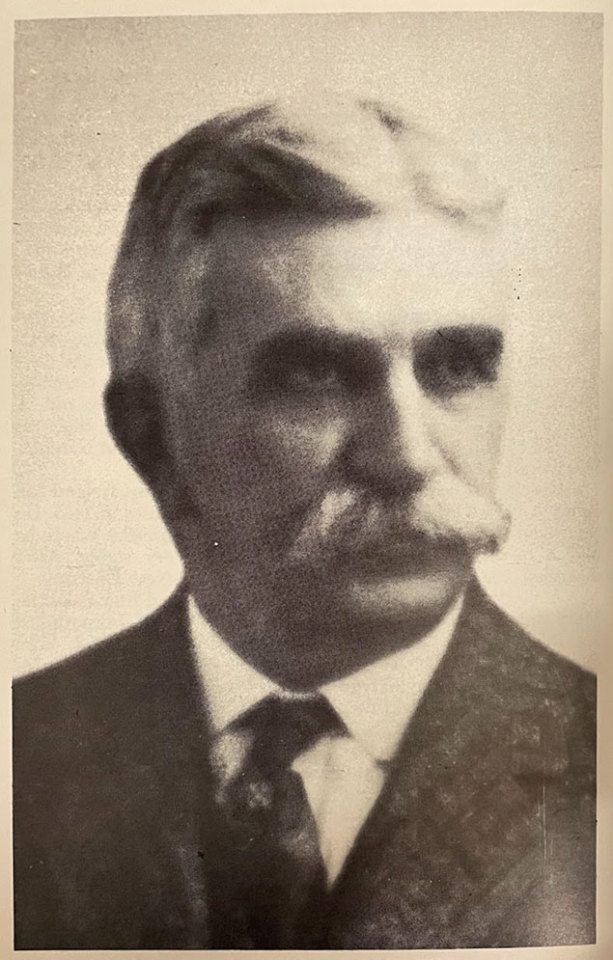
Cotton baron John M. Gracie, via The Jefferson County Historical Quarterly
Southern states used the system to address budget deficits and inadequate prison capacity after the Civil War, while providing a cheap and essentially disposable source of labor to the highest bidder.
“Convict leasing was a method of truly resurrecting something that looked almost exactly like the slavery that had existed before the Civil War,” said author Blackmon, who teaches at Georgia State University. “It was not typical for convicts to go back into the exact same kinds of plantation settings ... but Arkansas was a place where that did happen.”
Unlike purchasing the people Gracie’s ancestors enslaved, leasing prisoners didn’t require a substantial up-front investment for landowners. And if prisoners died doing the backbreaking work, others could quickly take their places.
Gracie signed contracts with local governments to use prisoners. They were housed on Gracie’s land, and the conditions were grim, according to newspaper accounts and government reports from the time. Men were whipped. Others died of heatstroke. One lost a foot to frostbite. At least a dozen prisoners, mostly Black men, lost their lives on Gracie land from 1890 to 1905, according to newspaper and state reports.
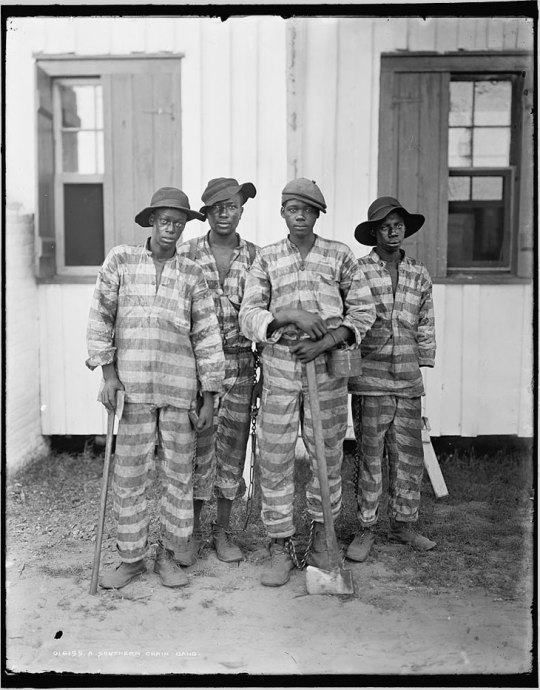
In 1888, for example, a state board reviewed a report by the penitentiary physician that examined the conditions at several prison labor camps. The report found 44 prisoners at a Gracie camp who, when not doing hard labor, were confined to a windowless pen measuring 20 feet by 20 feet. Ten years later, a Black man named Caesar Washington sued Gracie.
Washington had been pardoned by the governor of Arkansas, who noted his poor health. A petition presented by a government attorney mentioned, too, the fine and offense that put Washington on Gracie’s farm: $5 for “disturbing the peace by using profane and insulting language to a colored woman.”
In his lawsuit, Washington alleged that while serving on one of Gracie’s prison labor farms, he was “brutally beat, struck, whipped, kicked and maltreated.” The assaults were so bad, the 67-year-old shoemaker said, that he was left “wholly and permanently incapacitated from earning a living.”
Reuters could find no record showing how the suit against Gracie was resolved.
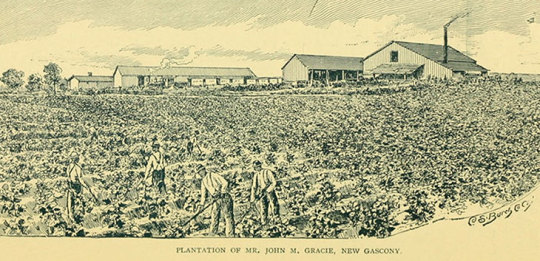
Amid similar allegations of mistreatment, Gracie thrived. He expanded the family’s farming operations, clearing thousands of acres of land around New Gascony and buying additional plantations near the Arkansas River. In 1908, news accounts said Gracie controlled 23,000 acres of land across multiple plantations and used as many as 250 prison laborers at a time.
Gracie’s precise profits are unclear. As of 1902, his contract with Pulaski County, for example, indicates he paid the local government 25 cents per day per prisoner, according to a newspaper account. Around the same time, the state of Arkansas’ own convict leasing operation, with a daily net cost of 27 cents per worker, produced a net profit of 48 cents – nearly twice as much as the cost of its labor.
After a 23-year run, Gracie ended his profitable business of using convict labor in 1909, as lawsuits and government investigations kept stacking up. In newspaper stories, Gracie had referred to the lawsuits by former prisoners as an “attempted hold up,” though he allowed that “it is impossible to handle a large number of convicts without sometimes resorting to somewhat extreme means in order to maintain discipline.”
But Gracie’s brutal practices didn’t affect his community standing. He was revered by white people in the Little Rock and Pine Bluff areas, where Gracie served as a senior executive for a bank and a railroad company. He supported local Catholic causes, helping to finance a school for Black children.
He and his family lived in Little Rock, in a Greek-revival mansion that he bought for as much as $7.6 million in today’s money. There, his wife and daughters threw parties for as many as 175 people, decorating with magnolia blossoms and Japanese lanterns.
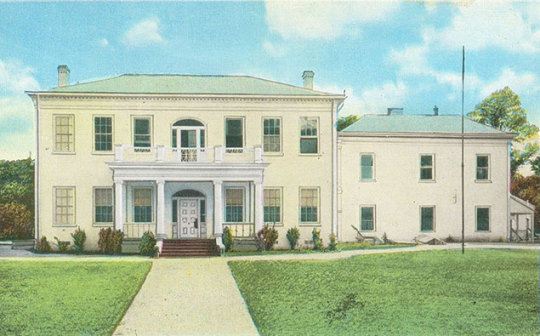
After he stopped using prisoners and Black tenant farmers, Gracie turned to Italian immigrants. But he soon soured on the Italian workers as “money mad” – they complained of debts they couldn’t work off and poor conditions, including holes in the floors of their cabins and rampant malaria. Many Italians left Gracie’s plantations. By 1918, several hundred Black tenant farmers once again worked his land, despite Gracie’s published comments years earlier in which he referred to Black laborers as “irresponsible, dishonest and very poor workmen” – a common racist trope.
His cotton empire began to crumble after prices crashed in 1920. Gracie would lose his farmland and sell the mansion in Little Rock. But in the lineage that leads to Congressman Hill, the family’s standing endured.
In 1924, Gracie’s granddaughter married another prominent Arkansan. Gracie died at the age of 76 in 1933 – the same year his granddaughter’s husband, James “Jay” Wilson Hill, established one of the first investment banking firms in the state.
Today, Gracie’s great-great-grandson is an accomplished member of Congress, representing Arkansas’ second congressional district since 2015. As a teenager, James French Hill worked summers at the family brokerage firm before attending Vanderbilt University. By his 30s, he was a U.S. Treasury Department official and a senior economic policy adviser to President George H.W. Bush.
In 1999, Hill helped found a Little Rock-based financial firm, Delta Trust & Banking Corp. Hill served as chairman and chief executive officer there.
Hill has shown a deep appreciation for history, describing himself as a ninth-generation Arkansan and serving as a commissioner for the Historic Arkansas Museum.
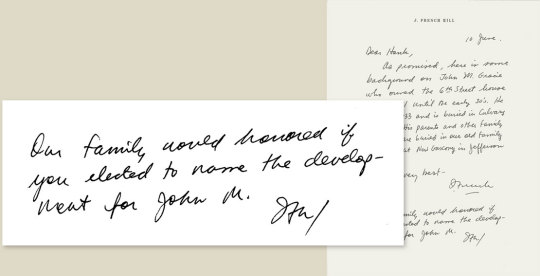
In 2011, when the former Gracie mansion was renovated with a loan from Hill’s Delta Trust bank, Hill wrote to the new owner. “Our family would (be) honored if you elected to name the development for John M,” the note read. It was.
In 2015, when Hill was sworn into Congress, he used a family Bible. It had been passed down from John M. Gracie’s father, a slaveholder.
Hill’s latest public financial disclosures show his net worth at between $10.3 million and $25.7 million, including his Little Rock residence. His holdings include a family investment vehicle with a name that echoes his family’s ancestral plantation: “New Gascony Company, LLC”.

Powerbrokers and the Leisure Economy
In 1820, Francis Hopkins enslaved 183 people on his cotton plantation along the coast of Georgia. The son of a British naval officer, Hopkins also was a member of the state legislature. He is the great-great-great-great-grandfather of U.S. Representative Dina Titus – and the single largest slaveholder among the ancestors of America’s political elite identified by Reuters.
Titus, in her seventh term in Congress representing the state of Nevada, is the direct descendant of at least seven slaveholders, Reuters found. Five of those ancestors lived in Georgia, where Titus was born and raised.
After the Civil War, the son of Francis Hopkins reached out to the local branch of the Freedmen’s Bureau, the agency set up to assist the formerly enslaved during Reconstruction. Thomas S. Hopkins, who had also been a slaveholder, lodged a complaint, bureau records show. “The ‘Freedman’ on his plantation refuse to work,” it read, and “he wishes them removed.”
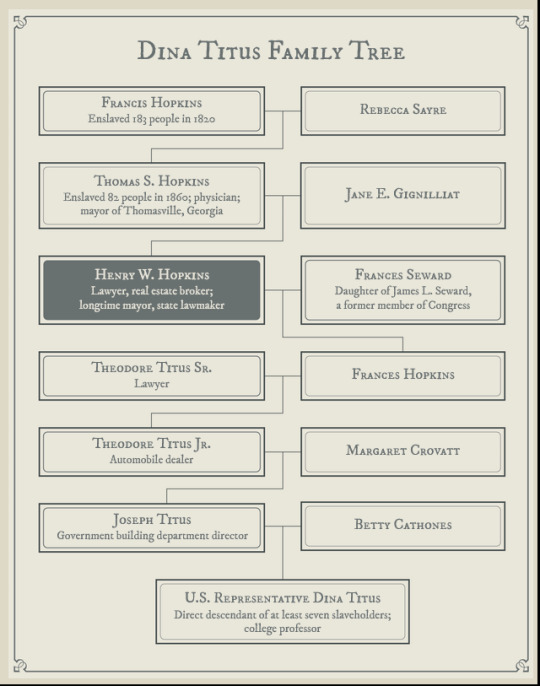
The message was a sign of things to come for the Hopkins family and the place they called home: Thomasville, a town in the deepest reaches of south Georgia.
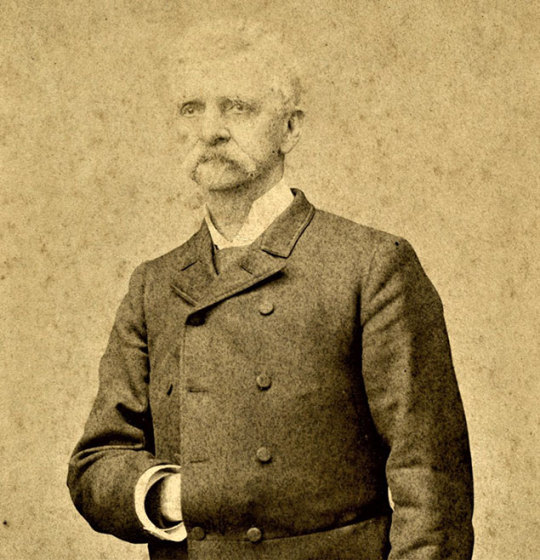
Thomas Spalding Hopkins, a physician, reimagined Thomasville as a place for those seeking relief from respiratory illnesses. Via Thomasville History Center
Many Southern landowners clung to farming, but this branch of the Hopkins family was largely forsaking agriculture. Thomas Hopkins was a physician, and by 1871 the mayor of Thomasville. Three years later, he presented a paper to the Medical Association of Georgia.
Dr. Hopkins contended that his town was the ideal place to recover from “consumption,” as tuberculosis was then called. In an 1882 letter published in the Atlanta Medical Register, he extolled the virtues of Thomasville’s “dryness of the climate” and the city’s distance from the Atlantic Ocean and the Gulf of Mexico, with their dangerous “saline vapor and moisture.”
His pitch, made through travel advertisements and testimonials to medical journals, effectively rebranded Thomasville as a destination for the ailing. The city was highlighted in a Harper’s magazine article in 1887, which described it alongside winter resorts that included the south of France, Switzerland and the Adirondacks.
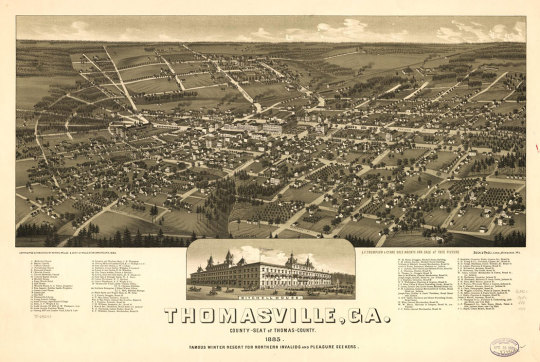
The son of Dr. Hopkins continued those efforts. But as Henry W. Hopkins himself became a prominent political figure, he used the family name and influence to launch an even greater transformation of Thomasville – one that in some ways capitalized on recreating elements of the antebellum South.
Often referred to as Judge Hopkins for one of the many offices he would hold, Henry married the daughter of a former U.S. congressman, who had also been a slaveholder. For parts of five decades that followed the end of Reconstruction, Judge Hopkins was one of the most influential men in the region.
From the mid-1880s through 1900, Hopkins spent nine terms as Thomasville’s mayor. When he wasn’t at city hall, he served in the state legislature – for 17 years between 1894 and 1926. Family papers reviewed by Reuters show Judge Hopkins traded favors with newspaper editors and politicians. He helped wealthy Northerners and Midwesterners, including Standard Oil heirs, acquire land, then hosted elaborate hunting trips. In the off-season, he often managed the plantations they bought.
In and around Thomasville, he built a social dynasty by brokering the sale of these plantations to monied outsiders, drawn to hunt quail and experience the old South.
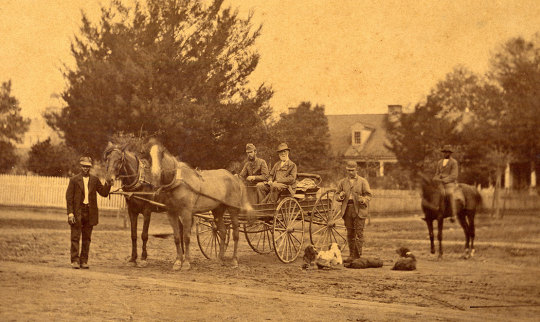
Southerners like Hopkins “basically ran these places like their fiefdoms,” said historian Hahn. “And poor white people and poor Black people were expected to bow down to them.”
These were “big families who wielded an enormous amount of patronage and either occupied local offices or had clients who did,” he said.
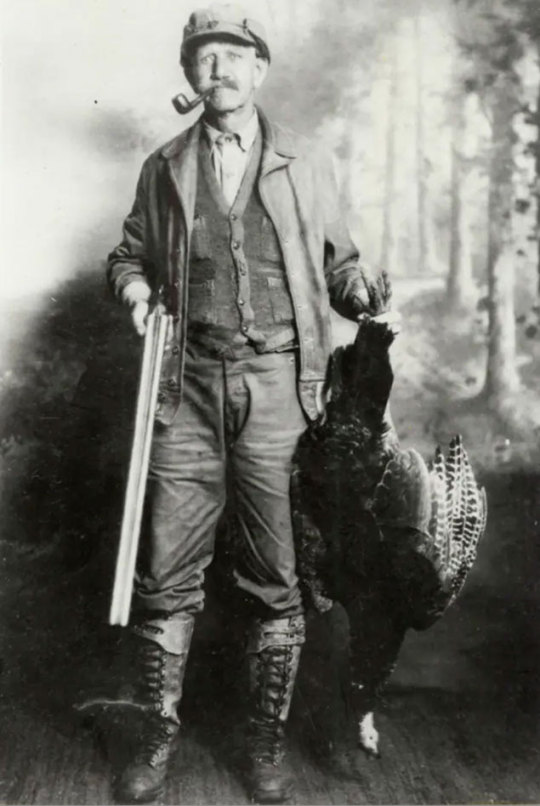
Through his law firm and real estate brokerage, Judge Hopkins “compiled, and eventually sold, almost every one of the original plantations that now are such a wonderful part of our southern life,” according to a book written by his great-grandson.
In the world Judge Hopkins helped create, the old plantations became country lodges. Well-to-do white people attended Christmas fox hunts and “fancy dress” balls where they danced the Virginia reel. Black families worked on those properties as servants and hunting guides. Part of the allure for some Northerners came in touring the homes of the county’s poorer Black residents.
“When it becomes clear that there is interest in vestiges of the old South … there’s a real sense that you can sell this,” said Julia Brock, a history professor at the University of Alabama who co-wrote a book about Thomas County and surrounding areas.
“There was a real interest in Black life,” Brock said. But that interest was in the nostalgia of the antebellum South, “not Black life as it was emerging into freedom.”
The economic success of the country-lodge plantations recaptured some of the Hopkins family’s standing as “part of a gentry,” Brock said, conferring upon him “a central place in a new social world.”
The system that now offered leisure for the wealthy still depended on Black labor, from tending dogs to driving carriages to serving supper to making sure quail nests were safe from natural predators.
It was “a feudal-type thing” for Black people, said Titus Brown, a history professor at Florida A&M University.
Brown, who co-wrote a book built around interviews with former employees of area plantations, said working on the leisure plantations was like living in a bubble. That leisure economy provided Black families with jobs and other benefits, including medical care and access to education. And it granted them “some protection, as long as they are not violating the social conduct or etiquette,” Brown said.
Judge Hopkins’ life and livelihood exemplified the nature of that social contract.
After a school for Black students burned down in a neighboring county, Hopkins donated land for a new location in Thomas County. He also connected Black people whom he knew to the white families who owned the plantations, recommending them for plum jobs.
But Hopkins had also been an early member of the Ku Klux Klan, and he sought to reassure white people that his vision for the region wouldn’t upset their primacy.
In 1905, for instance, state lawmakers debated whether to create a new county by peeling land from Thomas County and an adjacent county. Critics argued doing so would give Black residents an electoral advantage in two of the counties. Hopkins favored the move, and he testified before state lawmakers. According to The Atlanta Constitution, Hopkins “devoted his time to answering the argument of the opposition relating to negro domination,” and “closed with an eloquent reference to the fact that in Georgia the white race intended to dominate the negro race and control the government of the state, no matter how large the negro majority.” Judge H.W. Hopkins, an avid hunter, helped turn plantations into country lodges. Via Thomasville History Center
Judge Hopkins was in his 80s when sociologist Arthur Raper visited Thomasville in the early 1930s. Raper sought to explore the reasons behind lynchings in America, and two had taken place in Thomas County in 1930.
In one case, a Black man was accused of attacking a 9-year-old white girl. The man was jailed, and a mob gathered. When authorities tried to move the man to a different location, the mob wrenched him from the sheriff and told the man to run. Then they shot him repeatedly from behind.
The mob tied the man’s body to the back of a car and dragged him through town, his corpse almost hitting a pedestrian, Raper wrote. The killers did not bother covering their faces, according to Raper’s account. Still, no one came forward to identify them.
Raper wanted to learn more about the leaders of a town where such a thing could happen. Among those he interviewed was Judge Hopkins.
Hopkins and other leading citizens of Thomas County, Raper wrote, saw themselves as above poor white people. The sociologist referred to them as the “local landed aristocracy” and wrote of their paternalistic attitude toward Black people. Raper paraphrased it as: “Why you know, that fellow’s grandmother belonged to my mother’s father.”
Hopkins, he wrote, called lynchings the work of lower elements of white society: “I’ll give anybody a thousand dollars who’ll find either a son or a grandson of a slaveowner participating in a lynching.”
Raper found that Hopkins had once been a member of the Klan – using the phrase “the original Ku Klux Klan.” He was referring to the group’s first incarnation, when the Klan rose during the federal occupation of the South in the Reconstruction years. Writing in 1932, Raper said Hopkins had recently declined to join the reconstituted Klan.
Hopkins’ great-grandson later wrote of watching Judge Hopkins meet with “a group of hooded and sheeted figures” assembled on the lawn. They had come to ask him to “join in some sort of mission or action.” Judge Hopkins, according to his great-grandson, told the men to contact the police if a law had been broken. Otherwise, Hopkins told them, “you men must go home and hang up your robes for good.”
Judge Hopkins had no need to circumvent state power. He and others like him now were in control. Hopkins lived into his 90s, dying in 1945.
His great-great-granddaughter, Dina Titus, was born in Thomasville and grew up in Tifton, a town about 50 miles to the north. She graduated from the College of William and Mary, earned a master’s degree from the University of Georgia, then got a doctorate at Florida State University. She taught government for more than 30 years at the University of Nevada, Las Vegas.

Like her forebears, she pursued a career in politics. In 1988, she was elected to the Nevada State Senate, where she served as Democratic minority leader for 15 years. In 2008, she was elected to Congress.
Disclosure forms and real estate records show her net worth at between $978,000 and $2.5 million. The median U.S. family had a net worth of $193,000 in 2022, according to a survey for the Federal Reserve Board.
The Paralyzing Debt of Sharecroppers
The farm fields of Catahoula and Concordia parishes made white men rich and Black men miserable for many years in central Louisiana. Fed by a sprawling set of waterways, Concordia’s floodplains turned into what some call “million-dollar soil,” sprouting rows thick with cotton that were flanked by towering plantation homes.
Central Louisiana is where the ancestors of U.S. Senator John N. Kennedy came to secure their fortunes. In 1840, less than 30 years after Louisiana became a state, Kennedy’s great-great-great-grandfather enslaved 120 people in Concordia Parish. His estate in 1860 was worth about $57 million in current day dollars. His ancestor’s brother, a farmer and politician, enslaved 55 people on his Mississippi land in 1860. He then used cash from that estate – worth some $68 million in today’s dollars – to buy nearly 1,800 acres in neighboring Catahoula Parish.

After the Civil War, when the Black people they had enslaved were freed, the forebears of Kennedy were never again as rich. But they remained monied and powerful – a lineage of doctors, politicians and landowners surrounded by poor Black families.
Marriages between the descendants of slaveholders further grew their holdings. Among the senator’s direct ancestors was his great-grandfather, Leonidas Calhoun, who controlled large swathes of land along or near the Mississippi River Delta.
Calhoun went to medical school in Kentucky in the 1880s, then returned to live on a family plantation in Catahoula Parish. From there, he practiced medicine and oversaw hundreds of acres of farmland in Catahoula and adjacent Concordia Parish. He died in 1903 at age 44.
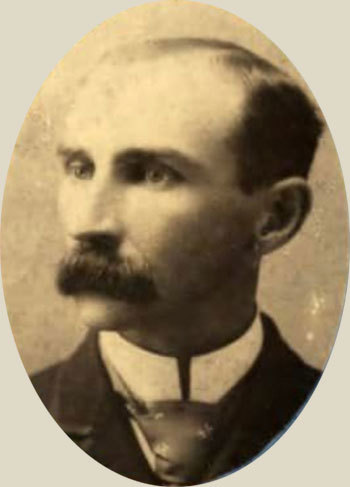
Portrait of Leonidas Calhoun. Via Facebook
At the time of his death, estate records examined by Reuters suggest that the Calhoun family was both sharecropping its land and also renting out larger tracts to tenant farmers.
In sharecropping, landholders typically gave farmers the right to live on and farm their land in exchange for a portion of the crops they produced. Farmers – those around the Calhoun land were typically Black and illiterate – often needed credit from their landlords simply to put a crop in the fields. Owners would front them everything from food and clothing to seeds and tools, typically provided at inflated prices and sold at stores on the plantations themselves.
After harvest, whatever was borrowed was deducted from the sharecropper’s earnings. In bad years, many may have owed more than they earned. Until those debts were repaid, laws forbade sharecroppers from leaving.
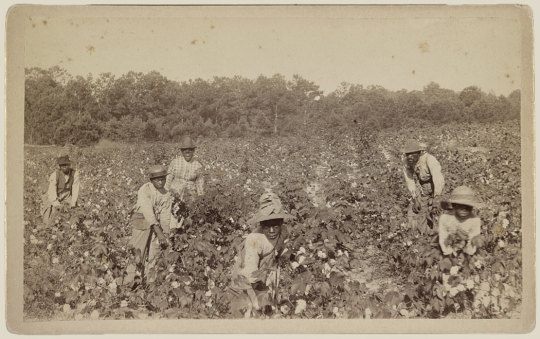
“During the end of the year, when it’s time for settlement, (landowners) would then pull out these accounting records to say, ‘Oh, you and your family almost made it out of debt,’” said Cassie Sade Turnipseed, a history professor at Jackson State University who has studied sharecropping in the Mississippi Delta.
Using the appraisal of Calhoun’s assets and matching them with census records, Reuters identified at least two Black farmers who owed Calhoun money at that time.

One was Granville Swift. Records show he owed $20 to Calhoun, and the debt was already at least six months past due. The 1900 census shows that Swift, a 23-year-old Black farmer, lived with his 22-year-old wife, who was a farmhand. Both were illiterate. Swift is also listed as a farmer in Catahoula Parish in the 1910 census, and records indicate he died there in 1918, at age 42. Reuters could find no evidence that he ever owned any of the land he farmed.
Another Black farmer who owed Calhoun money was Ben Polk. His debt was $5, according to estate records. The 1900 census for Catahoula Parish shows 49-year-old Benjamin Polk. He was listed as the head of a household with 10 other mouths to feed: his wife, eight children and one grandchild.
At some plantations, the owners issued their own scrip for use at their stores. Turnipseed, the scholar of sharecropping in the Mississippi Delta, said this meant that, even in profitable years, sharecroppers were unable “to acquire any kind of wealth because your currency would only be honored in very limited ways” on the plantation.
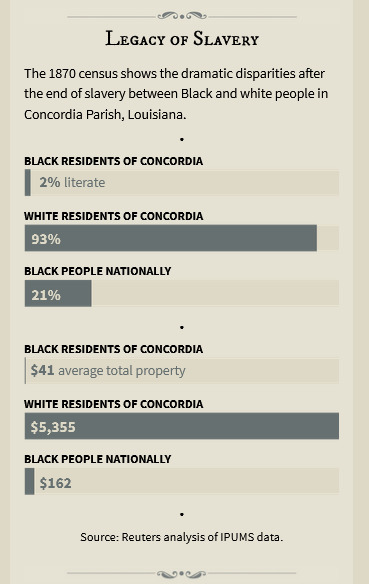
In an interview with Reuters, Ben Polk’s great-granddaughter recounted her ancestors’ description of working the Calhoun land.
Men in the family labored “sun up to sun down” in the cotton fields and had little autonomy, said Bettye Johnson, now 75. She said they were forced to buy food and goods on credit and at inflated prices in a plantation general store. Their debts often dwarfed their earnings, Johnson said.
“It was the Calhouns’ place,” Johnson said, “and they were in charge.” In the 1930 census, the occupation for Leonidas Calhoun’s son, who inherited the family land, was listed as “overseer” of a plantation.
The struggle to earn a living was intensified by violence and racial animus, some that was chronicled by the Calhoun family itself.
Legacy of Slavery
The 1870 census shows the dramatic disparities after the end of slavery between Black and white people in Concordia Parish, Louisiana.
During Reconstruction, Black residents of Concordia Parish gained power at the voting booth.
In 1860, about 91% of people living there were counted as “slaves,” the third-highest percentage of any county or parish in the United States, according to data from a recent study. After emancipation, Black people outnumbered white people in the parish 9,257 to 720.
Those figures underscore how important slavery was to families including the Calhouns, and how different the post-slavery political landscape became during Reconstruction. In the 1870s, Black men in Concordia were sheriffs and district court clerks. A formerly enslaved man was elected to the state legislature and then founded a newspaper.
A book by a local historian named Robert Dabney Calhoun, a nephew of Leonidas Calhoun, provided a window into how at least some local white people viewed those results. Black officeholders, Robert Dabney Calhoun wrote, were “illiterate, dishonest and sweating” men who carried out “unscrupulous designs.”
“Our substantial citizens were forced to engage in election manipulations,” wrote Calhoun. “They prayed for the dawning of the new day of white supremacy.”
That is what the white people of Concordia and surrounding parishes established for decades, by unleashing a deadly campaign in the 1870s.
“Lynchings, massacres, and terroristic intimidation was absolutely central to how many plantation dynasties reasserted dominance,” said John Bardes, a history professor at Louisiana State University, whose studies focus on slavery in Louisiana. “It was just horrific spasms of violence all throughout the state.”
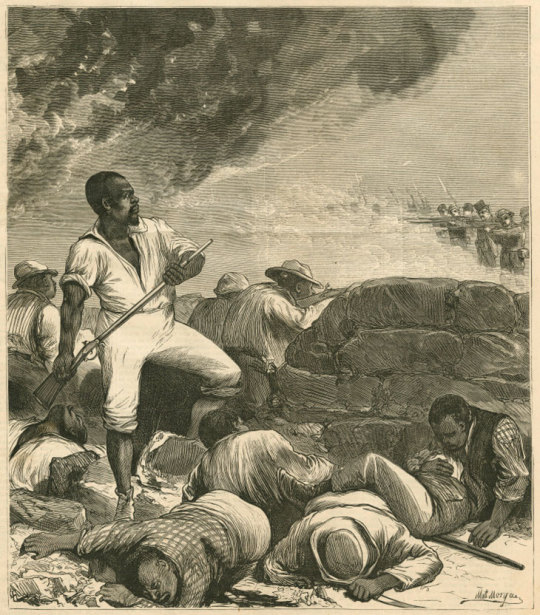
A recent report by the The Equal Justice Initiative found that Louisiana ranked third in the nation between 1877 and 1950 in what it terms “racial terror lynchings” – killings that were “acts of terrorism” outside of any legal proceedings. The state had 549 such murders in that period, the group found.
Around the time Leonidas Calhoun took control of the land in Concordia and Catahoula parishes, white people across the South had succeeded at reasserting political dominance. Another report by the Equal Justice Initiative notes that, “from 1885 to 1908, all 11 former Confederate states rewrote their constitutions to restrict voting rights using poll taxes, literacy tests, and felon disenfranchisement.”
Near the turn of the 20th century, changes in Louisiana tightly restricted who could vote. In 1897, before the changes, state records show 164,088 registered white voters and 130,344 registered Black voters. After the changes, records show 125,437 registered white voters and just 5,320 registered Black voters in 1900. The year after Leonidas Calhoun died, the number of registered Black voters across all of Louisiana had dropped to 1,718.
Today, the great-grandson of Leonidas Calhoun is the junior U.S. senator representing Louisiana. John Neely Kennedy – his middle name is the surname of two of his slaveholding ancestors – was president of his senior class at Vanderbilt University. He graduated from the University of Virginia School of Law, and earned a degree in civil law from Oxford University in England. Before being elected to the Senate in 2016, he spent five terms as Louisiana’s treasurer.

Real estate records and Kennedy’s latest public financial disclosures show his net worth is between $8.3 million and $22.6 million.
Kennedy doesn’t live in either Concordia or Catahoula parish. But after his mother died, he was named as one of the inheritors of her estate. Among her possessions listed in a 2005 probate document was hundreds of acres in Catahoula – family land that once belonged to one of Kennedy’s slaveholding ancestors.
Slavery’s Descendants
PART 1
America’s Family Secret
INTERACTIVE
Explore The Ties To Slavery
PART 2
“The Slaves Built That”
PART 3
“All We Are is Memory”
PART 4
American Dreams
PART 5
The Crown, the Cabinet and the UK’s Legacy of Slavery
PART 6
Heirs of Power
7 notes
·
View notes
Text
The Doctrine of Discovery | Friends Committee On National Legislation
Please don't tell me anything about how some shit religion like Christianity is good for Black Indigenous People globally because I know this is international law that is still relevant today.
The European colonizers utilized the Christian Doctrine of Discovery as a justification for their conquest and domination of indigenous peoples across the globe. This doctrine, originating from a series of papal bulls issued in the 15th century, granted European powers the right to claim lands and territories that were not inhabited by Christians..
This provided a moral and legal basis for the colonization of vast regions in Africa, Asia, and the Americas. The colonizers used military power to subjugate and control indigenous populations, often resorting to violence, murder, and enslavement to achieve their goals. The devastating impact of European colonization on indigenous peoples cannot be overstated, as it led to the destruction of cultures, the loss of land and resources, and the decimation of populations through disease, warfare, and forced labor.
The legacy of this brutal history continues to shape the world we live in today, highlighting the need for reconciliation and justice for the descendants of those who suffered under the yoke of colonialism. I can't do anything with evil and I don't care how anyone can justify this shit religion on anyone who knows the history and the laws that still exist today.
#black love#black positivity#black africans#black history#science#evolution#science side of tumblr#the doctrine of discovery
2 notes
·
View notes
Text


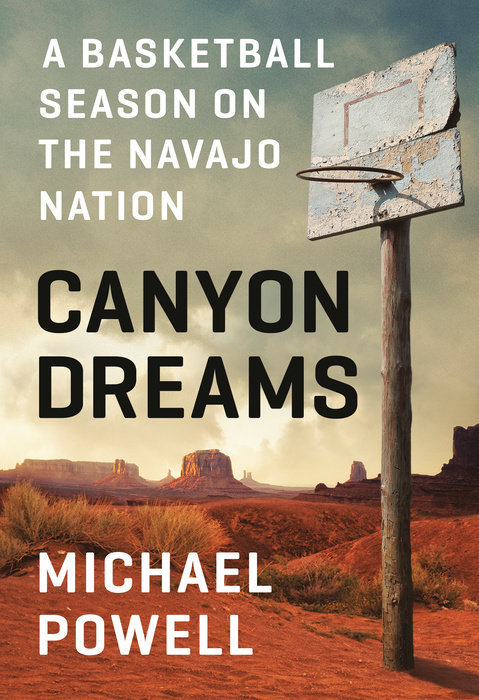

Nonfiction Thursday: Native American Heritage Month
A Mind Spread Out on the Ground by Alicia Elliott
In an urgent and visceral work that asks essential questions about the treatment of Native people in North America while drawing on intimate details of her own life and experience with intergenerational trauma, Alicia Elliott offers indispensable insight into the ongoing legacy of colonialism. She engages with such wide-ranging topics as race, parenthood, love, mental illness, poverty, sexual assault, gentrifcation, writing and representation, and in the process makes connections both large and small between the past and present, the personal and political - from overcoming a years-long battle with head lice to the way Native writers are treated within the Canadian literary industry; her unplanned teenage pregnancy to the history of dark matter and how it relates to racism in the court system; her childhood diet of Kraft Dinner to how systemic oppression is directly linked to health problems in Native communities.
With deep consideration and searing prose, Elliott provides a candid look at our past, an illuminating portrait of our present, and a powerful tool for a better future.
An Afro-Indigenous History of the United States by Kyle T. Mays
Beginning with pre-Revolutionary America and moving into the movement for Black lives and contemporary Indigenous activism, Afro-Indigenous historian, Kyle T. Mays argues that the foundations of the US are rooted in antiblackness and settler colonialism, and that these parallel oppressions continue into the present. He explores how Black and Indigenous peoples have always resisted and struggled for freedom, sometimes together, and sometimes apart. Whether to end African enslavement and Indigenous removal or eradicate capitalism and colonialism, Mays shows how the fervor of Black and Indigenous peoples calls for justice have consistently sought to uproot white supremacy.
Mays uses a wide-array of historical activists and pop culture icons, "sacred" texts, and foundational texts like the Declaration of Independence and Democracy in America. He covers the civil rights movement and freedom struggles of the 1960s and 1970s, and explores current debates around the use of Native American imagery and the cultural appropriation of Black culture. Mays compels us to rethink both our history, as well as contemporary debates, and to imagine the powerful possibilities of Afro-Indigenous solidarity.
Canyon Dreams by Michael Powell
Deep in the heart of northern Arizona, in a small and isolated patch of the vast 17.5-million-acre Navajo reservation, sits Chinle High School. Here, basketball is passion, passed from grandparent to parent to child. Rez Ball is a sport for winters where dark and cold descend fast and there is little else to do but roam mesa tops, work, and wonder what the future holds. The town has 4,500 residents and the high school arena seats 7,000. Fans drive thirty, fifty, even eighty miles to see the fast-paced and highly competitive matchups that are more than just games to players and fans.
Celebrated Times journalist Michael Powell brings us a narrative of triumph and hardship, a moving story about a basketball team on a Navajo reservation that shows how important sports can be to youths in struggling communities, and the transcendent magic and painful realities that confront Native Americans living on reservations. This book details his season-long immersion in the team, town, and culture, in which there were exhilarating wins, crushing losses, and conversations on long bus rides across the desert about dreams of leaving home and the fear of the same.
We Refuse to Forget by Caleb Gayle
In We Refuse to Forget, award-winning journalist Caleb Gayle tells the extraordinary story of the Creek Nation, a Native tribe that two centuries ago both owned slaves and accepted Black people as full citizens. Thanks to the efforts of Creek leaders like Cow Tom, a Black Creek citizen who rose to become chief, the U.S. government recognized Creek citizenship in 1866 for its Black members. Yet this equality was shredded in the 1970s when tribal leaders revoked the citizenship of Black Creeks, even those who could trace their history back generations - even to Cow Tom himself.
Why did this happen? How was the U.S. government involved? And what are Cow Tom's descendants and other Black Creeks doing to regain their citizenship? These are some of the questions that Gayle explores in this provocative examination of racial and ethnic identity. By delving into the history and interviewing Black Creeks who are fighting to have their citizenship reinstated, he lays bare the racism and greed at the heart of this story. We Refuse to Forget is an eye-opening account that challenges our preconceptions of identity as it shines new light on the long shadows of white supremacy and marginalization that continue to hamper progress for Black Americans.
#native american history#nonfiction#social justice#reading recommendations#reading recs#book recommendations#book recs#library books#tbr#tbr pile#to read#booklr#book tumblr#book blog#library blog#readers advisory
11 notes
·
View notes
Text
Supreme Court Justice Ketanji Brown Jackson’s marriage to her husband and familial history was dissected by The Washington Post in an article from Monday about slavery.
The article was headlined, "Ketanji Brown Jackson’s ancestors were enslaved. Her husband’s were enslavers," and detailed the ancestral history of slavery and enslavement in the families of the justice and her husband, Patrick Jackson.
"When John Greene, believed to be an ancestor of Supreme Court Justice Ketanji Brown Jackson, got off a schooner from Trinidad in Charleston, S.C., he was immediately enslaved and dispatched to a plantation, according to family lore. When John Howland, the 10th-great-grandfather of Jackson’s husband, Patrick Jackson, disembarked the Mayflower at Plymouth, Mass., he was given housing and several acres," The Washington Post wrote.
The Post continued to scrutinize the Supreme Court justice and her husband’s family history, drawing parallels between the two that date back over 100 years.
"Ketanji Brown Jackson, one of the country’s nine most powerful legal arbiters, tracks her family history through generations of enslavement and coercive sharecropping. Patrick Jackson, a gastrointestinal surgeon in D.C., counts among his ancestors King Edward I of England, four Mayflower passengers and a signer of the U.S. Constitution."
The paper cited Christopher C. Child, senior genealogist with the New England Historic Genealogical Society in Boston, who found that Patrick Jackson's "great-great-great-great grandfather Peter Chardon Brooks was the richest man in New England when he died, having made his fortune insuring ships, including some involved in the slave trade."
In addition, the article explained, "Patrick was raised outside Boston, but his maternal grandfather’s ancestors lived in the South. Based on public slave schedules from 1850 and 1860, Child estimates the family owned about 189 enslaved people at the time. ‘Every male ancestor of Patrick’s maternal grandfather over the age of 21 alive in 1850 or 1860 was a slaveowner,’ Child said. One of his ancestors was also a Confederate soldier."
Florida Gov. Ron DeSantis’ press secretary, Jeremy Redfern, shared the article with his over 49,000 followers Monday.
"What an insane premise to discuss someone’s marriage," he wrote. It’s ‘She was oppressed. He was the oppressor.’ Even though neither of them have anything to do with what their ancestors did over 150 years ago."
Some of Ketanji Brown Jackson’s family members were reportedly unconcerned about the over 100-year-old history of her husband’s family.
"We had two people who loved each other, and that was enough. You can’t rewrite history. It is what it is," Ketanji Brown Jackson's uncle, Calvin Ross, reportedly told The Post.
The justice herself referenced both her and her husband's backgrounds in a 2017 speech, according to The Post. "We were an unlikely pair in many respects," she said in a 2017 speech, "but somehow we found each other."
Neither Ketanji nor Patrick Jackson responded to interview requests from The Washington Post, according to the article.
Fox News Digital has reached out to the Supreme Court for additional comment but has yet to receive a response.
13 notes
·
View notes
Text
To the editor: As African Americans, we are not surprised that a significant majority of non-Black Californians oppose the idea of the state offering cash payments to the descendants of enslaved Black people.
Public opinion does not form in a vacuum. For decades the media have besmirched the image of African Americans, often depicting us as violent criminals, welfare queens and parasites. In contrast, the requests of other groups who were not subject to widespread media vilification have been more favorably received.
For example, large numbers of Americans endorsed cash payments to Japanese citizens who were incarcerated in prison camps during World War II. The same can be said of financial redress granted to Native Americans.
Let us be clear: 246 years of free labor from millions of Black people anchored this nation’s early development and ultimately catapulted America into becoming a modern superpower. In a capitalist system, cash is the best way to provide restitution to the formerly enslaved, and the media should report this fact to set the record straight on America’s unique indebtedness to Black people.
Patricia A. Moore, Compton
The writer is national chair for reparations at the National Assn. for Equal Justice in America.
..
To the editor: The headline surely led most readers to believe that cash payments to descendants of enslaved people are the primary focus of the recommendations proposed by the California Reparations Task Force.
In mentioning other recommendations, the article chose those that would likely be hot-button issues for those who oppose reparations.
Focusing on ending the death penalty, paying fair market value for jail and prison labor, and restoring voting rights to all formerly and currently incarcerated people treats as secondary the long-ranging recommendations that are intended to address the after-effects of slavery and racial discrimination. The massive disparities have affected Black people in every walk of life.
Touching on recommendations that will have an impact on eliminating these disparities would have given readers a more balanced view of what the task force is attempting to accomplish.
Denise Flanagan, Riverside
..
To the editor: Slavery was abolished in the U.S. in 1865. If a single generation is 25 years, more than six have passed since then.
The Great Famine in Ireland, which killed about 1 million people, took place during roughly the same period (1840s-50s). The famine was a direct cause of the overlording British taking Ireland’s crops for their own consumption.
With generations having passed since then, it has never occurred to me to seek reparations from the British due to their mistreatment of my ancestors.
If Gov. Gavin Newsom has aspirations for a continued political career, he had better dump this idea immediately. Not only is paying cash reparations a bad idea, the right-wing media will make sure it sticks to him like Hillary Clinton’s emails did to her.
Dan O’Connell, Santa Clarita
..
To the editor: It’s not surprising to see resistance to cash reparations because the ground has not been prepared for our nation to accept responsibility for the consequences of chattel slavery.
To understand why, look only to the unwillingness to educate our young about the oppression of Black people because some feel non-Black children might feel bad.
This ought to be the fundamental message: Our tradition of justice requires that people suffering damages be made whole.
I suggest three areas for remediation: enhancements in the health, wealth and educational opportunities of traditional Black communities. These might take the form of greatly improved free schools and medical facilities, preferential small business and mortgage programs, and the means to pass on generational wealth.
Some may suggest other forms of remediation. But first, a persistent campaign must persuade the majority that justice is long overdue.
Philip Baer, North Hollywood
https://x.com/KamilahVMoore/status/1702743762785693851?s=20
#Reparations#AB3121#https://x.com/KamilahVMoore/status/1702743762785693851?s=20#Kamilah Moore#California#Reparations for Black Freedmen
7 notes
·
View notes
Text

The Juneteenth flag is full of symbols. Here's what they mean
Harmeet Kaur, CNN Design by Will Mullery, CNN

Editor's Note: (A version of this story was initially published in June 2020.)
(CNN)You might see another red, white and blue flag flying this weekend over state capitols and city buildings.
That banner with a bursting star in the middle is the Juneteenth Flag, a symbolic representation of the end of slavery in the United States.
The flag is the brainchild of activist Ben Haith, founder of the National Juneteenth Celebration Foundation (NJCF). Haith created the flag in 1997 with the help of collaborators, and Boston-based illustrator Lisa Jeanne Graf brought their vision to life.https://0ebfd95186ae3fa9ef9151a3c904e7bb.safeframe.googlesyndication.com/safeframe/1-0-40/html/container.html?n=0
The flag was revised in 2000 into the version we know today, according to the National Juneteenth Observation Foundation. Seven years later, the date "June 19, 1865" was added, commemorating the day that Union Army Maj. Gen. Gordon Granger rode into Galveston, Texas, and told enslaved African Americans of their emancipation.
For two decades now, communities around the country have held flag-raising ceremonies on Juneteenth in celebration of their freedom.
"This country has so many aspects to it that are spiritual, and I believe this flag is of that nature," Haith said. "It (the idea for the design) just came through me."
View this interactive content on CNN.com
Designing the flag and its symbols was a deliberate process, Haith said. Here's what each element of the flag represents.
The star

The white star in the center of the flag has a dual meaning, Haith said.
For one, it represents Texas, the Lone Star State. It was in Galveston in 1865 where Union soldiers informed the country's last remaining enslaved people that, under the Emancipation Proclamation issued two years earlier, they were free.
But the star also goes beyond Texas, representing the freedom of African Americans in all 50 states.
The burst

The bursting outline around the star is inspired by a nova, a term that astronomers use to mean a new star.
On the Juneteenth flag, this represents a new beginning for the African Americans of Galveston and throughout the land.
The arc

The curve that extends across the width of the flag represents a new horizon: the opportunities and promise that lay ahead for Black Americans.
The colors

The red, white and blue represents the American flag, a reminder that slaves and their descendants were and are Americans.
June 19, 1865, represents the day that enslaved Black people in Galveston, Texas, became Americans under the law.
And while African Americans today are still fighting for equality and justice, Haith said those colors symbolize the continuous commitment of people in the United States to do better -- and to live up to the American ideal of liberty and justice for all.
10 notes
·
View notes
Text
“Free Palestine”—the slogan, the fantasy, and the policy—has always consciously implied the mass murder of Jews in their towns, streets, shops, and living rooms. Few are willing to say so openly, but in many intellectual, professional, and popular circles in the Middle East and the West, the idea of Palestinian national liberation has long been framed in terms that condone or necessitate the indiscriminate killing of Jews. For more unambiguous actors such as Hamas and the Islamic Republic of Iran, freeing Palestine simply means the total eradication of Israel without qualification. This is not a polemical point, but a basic reality and fact of our lives that demands scrutiny. Consider the ideological milieu in which many Arabs and Muslims have been raised, including me. Growing up as a Muslim in Egypt, the concept of Palestine was never a geopolitical issue; it was a deeply ingrained part of our collective moral identity, the unifying element of both our religious and secular Arab nationalism. It was, and remains, a cause that resonated with us politically, socially, and spiritually, often approaching a fervor that defies rationality. This emotional charge, embedded in the political and religious narratives of much of the Arab Muslim world, has made rubbish of the idea that the Palestinian cause is merely based on anti-Zionism rather than antisemitism. This milieu, however, is not in any way essential to what it means to be Arab or Muslim—it is a thoroughly modern phenomenon shaped largely by the influence of European revolutionary ideologies on Arab intellectuals and political activists. Among these imported systems of thought is a strain of revolutionary antisemitism that casts Jews as the eternal enemy not just of Arabs but of all human beings. Not every Arab or Muslim subscribes to these views, of course, but when fused with preexisting religious and cultural biases, they have infected almost every institution, pattern of thought, and aspect of life in the Arab Muslim world. Modern Arab political and religious literature is filled with the claim that Jews are hostis humani generis, the enemies of mankind—a classical European libel, and a French revolutionary cry. The problems of this poisonous strain of thought are compounded by the concept that “freeing Palestine” is a species of resistance against foreign settler colonialists, a Fanonian revolution in which violence against civilians is defended as a legitimate means of achieving racial justice. The wholesale labeling of Israeli Jews—the vast majority of whom are refugees or descendants of refugees from Arab Muslim dictatorships and Soviet totalitarianism—as colonizers, settlers, and imperialists is in fact a type of collective ethnic punishment, nonsensical even on its own twisted terms, which recalls the medieval Christian denunciation of Jews as moral abominations, as a group and as individuals.
You might have noticed in the last few days that those committed to liberating Palestine can’t seem to avoid the abject dehumanization of the Jews as a people—and that their aim is not for Palestinians to simply live in peace, dignity, and freedom alongside Israelis, but a state that is necessarily established upon the ruins of Israel. Hamas is explicit in its intention to murder the Jewish population of Israel and enslave any survivors; its partisans in the Middle East and the West are coyer on this point.
Islamists articulate the fantasy of Jewish eradication in the language of jihad, framed in eschatological terms, and imbued with a sense of divine justice and cosmic warfare—what Westerners would ordinarily recognize as a type of religious fascism. But while the Islamist version of this idea is potent for the purposes of mobilizing the impoverished and uneducated masses, the “left-wing” or secular version—couched in the language of Fanon and Karl Marx, of human emancipation, equality, anti-capitalism, and social justice—is the more effective means of mobilizing opinion among the Western intelligentsia. The point is that they are two sides of the same coin, the value of which is set in Jewish blood.
For those who are shaped by such a worldview—whether the “right-wing” or the “left-wing” version, the religious or the atheistic—celebrating the murder of innocent Israeli civilians, including children, women, and the elderly, is an expression of the partial fulfillment of a moral vision. As a teenager in Egypt, I recall nearly all the adults around me expressing such feelings when following the news of suicide bombings targeting Israeli civilians during the Second Intifada. Egypt’s most prominent religious authorities declared the perpetrators to be martyrs and saints. In a way, it was not unlike the valorization and even canonization of those who destroyed livelihoods, burned property, and targeted police officers during the protests in America in the summer of 2020. I do not mean to inject American domestic politics where they do not belong, or to suggest a perfect moral equivalence, but there is a reason that leaders of Hamas and the Islamic Republic of Iran themselves insist that they are engaged in the same struggle against racism.
Almost every Arab Muslim knows that what I’m describing is not a personal opinion but objective reality. We may try to belittle these facts, or dismiss them as the delusional daydreams of uneducated know-nothings under the influence of religious and populist fanatics. But we should not deny that they are true.
My fear is that the impulse to dismiss and belittle is the byproduct not of sincere belief but of a deep sense of helplessness. After many recent conversations with the rising generation of young, intelligent, Westernized, and highly educated Arab professionals and diplomats, I have witnessed a strong urge not to confront this reality. Even among those who genuinely accept the legitimacy of Israel in a way their parents would have never been capable of, I almost always hear them describe the deaths of innocent Israelis as somehow being their own fault, or at least the fault of the Israeli government for not unilaterally making peace and ending the conflict. There is nothing more depressing than the surrender of the young to a problem they see as too big to solve.
Those of us who belong to the cosmopolitan professional class of Arabs, who jump from country to country and from one lifestyle to another, benefiting from foreign cultures that live on the moral currency of liberalism and tolerance, are in many cases secretly ashamed. We see the antisemitism, the bloodlust, the insanity, and we cringe—but we hope it goes away. It’s easier for us to look forward to a hypothetical future where things are otherwise. It’s easier to ingratiate ourselves to the new social world where we want to belong, rather than grapple with the failures of the one we’ve left behind. We dismiss, we belitte, we explain away, we say, “What about Shireen Abu Akleh?”—and we go on pretending.
To the Arabs of my own generation, I say we need a truly different approach. I’m not asking you to love Israel or Zionism, or to hang a poster of hipster Herzl in your bedroom. If you are critical of Israel and think there should be a Palestine, continue to do so. All I ask is for you to be authentically courageous, to admit that the murder we all witnessed in the last few days is an accurate representation and logical consequence of a catastrophic moral system, the one we all know intimately. This is a moment for collective introspection. It’s time to confront the darker corners of our ideological heritage, and question the ideas and beliefs we may have uncritically absorbed. Only by doing so can we hope to contribute to a more constructive and humane world for ourselves.
6 notes
·
View notes